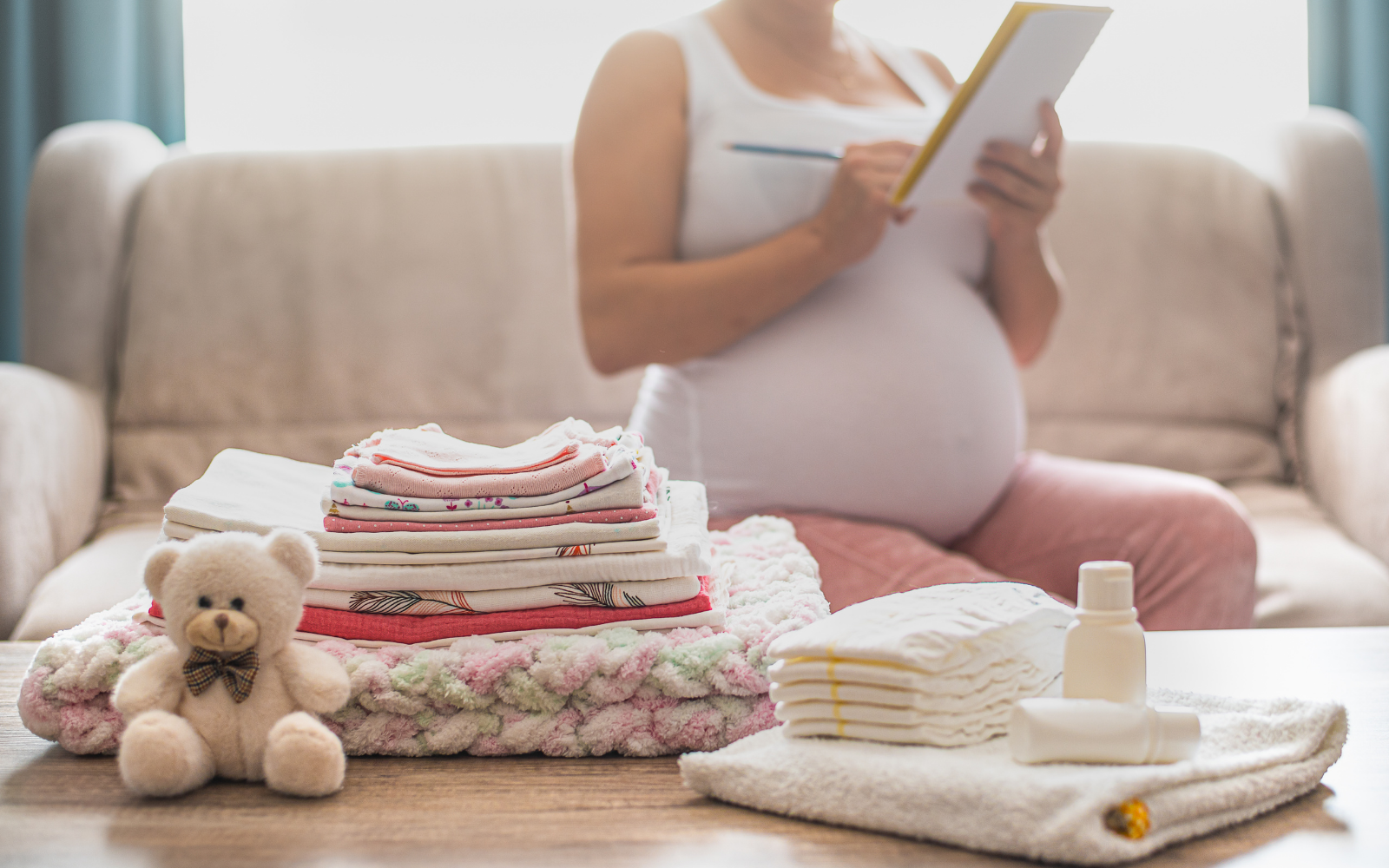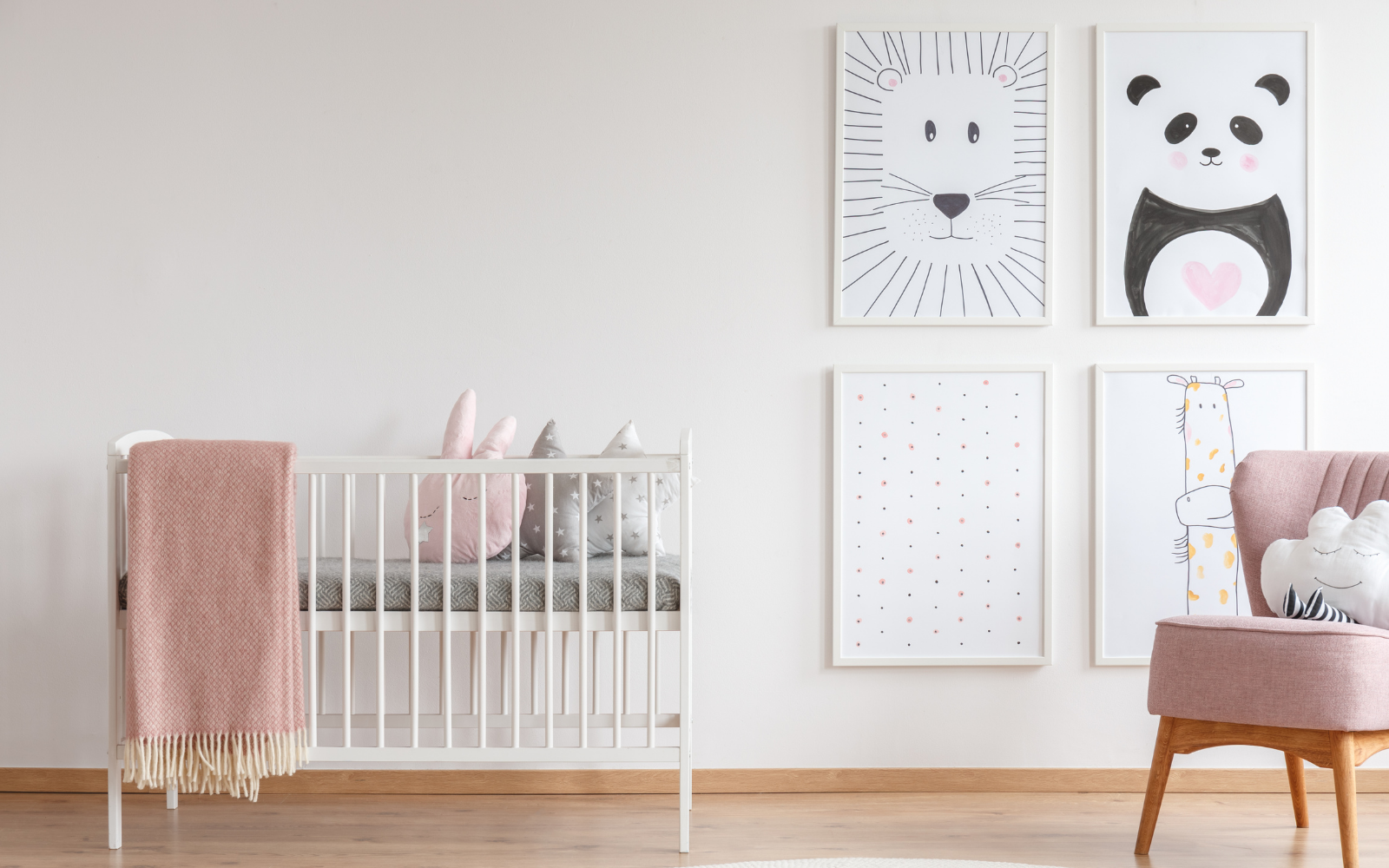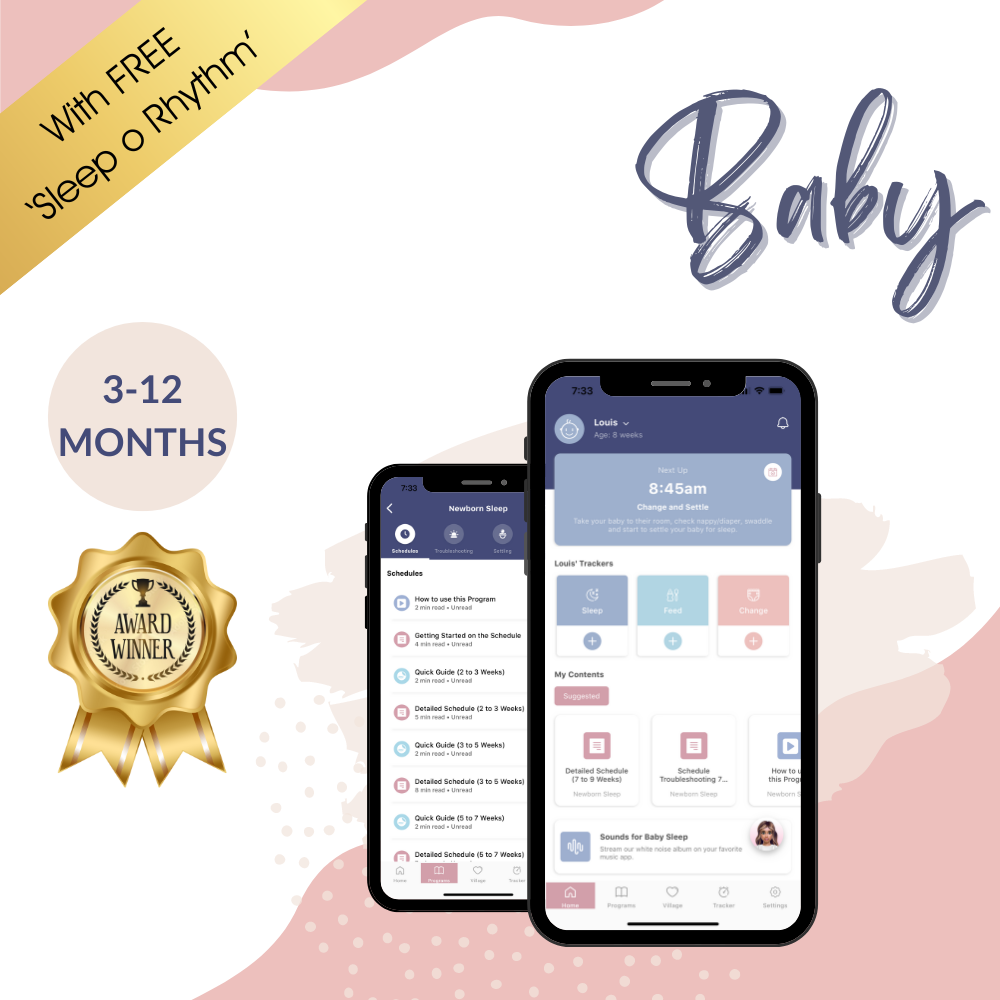
Setting up a nursery for your baby
Setting up the nursery for a new baby can be an exciting time for some parents, but for others, it can feel overwhelming. When should you start to prepare for your baby’s arrival? What does a newborn baby actually need? Where should you place the cot? If you are feeling confused about where to start with nursery design, read on for some helpful tips.
In this article:
- When should I start setting up a nursery for my baby?
- What do I need in my baby's nursery?
- How much does it cost to set up a nursery?
- Tips for designing a nursery
- Tips for nursery organisation and storage
When should I start setting up a nursery for my baby?
Most people regard the second trimester as the best time to start setting up the nursery. At this stage in your pregnancy, you should hopefully be over the morning sickness and fatigue but will still be able to move around with relative ease and comfort. It also means the nursery will be ready even if your baby decides to arrive a little earlier than anticipated!
If you’re planning to hold a baby shower later in your third trimester though, you may just want to focus on the major items like furniture, paint and textiles to start with and wait to see what you are gifted from friends and family. If there are certain items you need or want, you could also consider setting up a gift registry for your baby shower.
It helps to remember too that most safe sleep guidelines recommend sharing a room with your baby for the first 6 months so if you are short on space, time, energy or money, there’s really no rush to set up a nursery. You can start by establishing a space for your baby in your bedroom and set up the nursery at a later date.
Need support figuring out your newborn's sleep?
Being a new parent can be overwhelming. You probably have lots of questions. Find the answers to all your questions and more in our Sleep Programs to future-proof your newborn's sleep.
Get our Sleep Programs
What do I need in my baby’s nursery?
If you’ve spent time scrolling through social media, you might be thinking that your baby needs a perfectly coordinated, designer nursery. In reality though, your baby doesn’t care what the nursery looks like, all they need is:
- a place to sleep
- a place to be fed
- a place to be changed
- a place to keep clothes and other items
For the first 6 months, you can give your baby what they need by setting up a space in your own room - using a bassinet or bedside crib, devoting part of your closet or dresser to their clothes and nappies and changing them on a mat on the floor or bed. Feeding can be done in any comfortable chair you have around the house.
If you have a separate room to use for your baby’s nursery, you can easily set this up with the basics and then add to it later on. It doesn’t all need to happen at once and it doesn’t need to cost a fortune either!
How much does it cost to set up a nursery?
The cost of setting up a nursery varies quite a bit from one person to the next. You could spend anywhere from $500 to $5000 or more, depending on whether you stick to the basics or go all out creating that designer nursery of your dreams. As a rough estimate though, you could expect to spend the following amounts:
- In the UK, a 2025 survey of parents found that they spent an average of £853 on furniture, decor and bedding for their baby’s nursery (1).
- In Australia, in 2025, the average cost of a basic nursery set-up was $1375 (2).
- In the US, a 2025 article recommends budgeting $2000 for nursery basics such as a cot, changing table, feeding chair and bedding (3)
If you are on a budget, here are some tips for reducing the costs associated with setting up a nursery:
- Consider buying second hand. For safety and health reasons, it is recommended to buy a new bassinet/cot/crib or at least a new mattress but most other items can be bought second hand.
- Upcycle existing furniture. An old dresser can easily be converted into a change table/dresser combo and any comfy armchair can be used as a feeding chair.
- Look for clever furniture hacks online using cheaper options from stores such as IKEA and Kmart.
- Skip fancy bedding sets. All you really need is a mattress protector and some fitted sheets. It’s worth noting too that some of the pieces included in bedding sets, such as cot bumpers and pillows, are actually not safe to use when your baby is sleeping in the cot.
- Decorate with free printable wall art. A few cute, framed prints can make any room feel more inviting. Start by checking out our free nursery print sets that come in four different themes... Animal Print Sets, Bunny Print Sets, Ocean Print Sets, and Vintage Wild Print Sets.
- Start planning early to keep an eye out for sales. Starting early also gives you more of an opportunity to shop around and score some bargains.
- See if friends or family have baby items they no longer need. You will likely find people are more than happy for you to take their unused baby items away.
Say goodbye to sleepless nights.
Join over 800,000 families worldwide who are enjoying excellent sleep with our Sleep Programs, created by experts in the field of pediatric sleep.
Get our Sleep Programs
Tips for designing a nursery
When it comes to designing the nursery, there are three key things you’ll want to consider - style, functionality and safety.

Style
Decide on an overall style/theme. This can simply be an extension of your own style if you want to keep things consistent. If you do want to give your baby’s room its own theme though, some popular options include:
- Celestial
- Jungle/safari
- Neutrals
- Forest/woodland
- Dinosaurs
- Rainbows
- Nature/greenery
Pick a colour palette. For your primary colour, which will be the dominant colour in the room, it’s a good idea to stick with something more neutral like white, black, off-white, grey, taupe, blush or beige. Then you can add some additional pops of colour in the form of paint, textiles and decorative items.
Choose textiles before paint. It’s much easier to pick a paint colour that coordinates with your curtains and bedding than to try to do it the other way around!
Functionality
When designing your nursery, think beyond the newborn period. Are you planning on using your nursery furniture for more than one baby? Do you want a cot that can transition to a toddler bed later on? Will you redesign the room as your baby gets older or do you want a style that will last through the years?
For your nursery to function effectively, consider the three main activities that will take place in the room - feeding, sleeping and changing.
Feeding
Although you can feed your baby in any comfy chair around the house, it is nice to have a dedicated feeding station in your baby’s nursery. Typically, a feeding station will include:
- A comfortable feeding chair. Focus less on the style here and more on how comfortable it is - after all, you’ll be spending a lot of time in this chair! You’ll want to make sure the arm rests are at a comfortable height and padding helps too. Chairs that rock or glide can be helpful for settling your baby to sleep after a feed but aren’t really necessary.
- A side/end table with a drawer. This is handy to store all manner of feeding-related items such as breast pads, burp clothes and snacks. It also gives you somewhere to keep a drink bottle or glass of water and your phone or a clock to keep track of the time.
Sleeping
Since your baby will spend most of their time in the nursery sleeping, this needs to be a high priority! Whether they are in your room or in their own room, we recommend the following:
- Try to maintain a consistent room temperature through the use of a fan, air conditioner and/or heater with a thermostat. Babies generally sleep best when the room temperature is between 18-20C.
- Keep the room as dark as possible with the use of blackout blinds or curtains as this will promote the release of melatonin - the hormone that helps us to both fall asleep and stay asleep. We recommend sleeping babies in a dark room for both naps and overnight sleep.
- Get a dim nightlight that you can use to navigate middle of the night feeds and nappy changes. We also recommend a white noise machine or app that can play continuous white noise during your baby’s naps and overnight sleep. Some nightlights have an in-built white noise machine and some have a humidifier function as well.
- Position the crib/cot away from windows and outside walls. This helps with temperature regulation since windows and outside walls can get chilly in the colder months. Positioning your baby away from windows also helps to prevent light waking them and keeps them away from blinds and curtains.
- Follow safe sleep guidelines when setting up your baby’s cot/crib - use a firm mattress and avoid cot bumpers, pillows or loose blankets/toys.
Let's get your little one's sleep sorted ASAP!Our award-winning Sleep Programs will solve your baby's sleep challenges in no time.
Get our Sleep Programs
Changing
Changing your baby’s nappy is another activity that can be done anywhere - all you need is a changing mat and a flat surface. A dedicated change table can be really handy though as it helps to make sure everything you need is easily accessible. To save space, you could also consider a combination changing table/dresser. Storing nappies, wipes and creams in baskets also helps to keep things neat and tidy.
.png?alt=media&token=e39ae9a5-6e49-42b1-af57-041cf06c4dcc)
Safety
The final thing you’ll want to do when designing your baby’s nursery is to make sure the room is safe. Although your baby won’t be moving around for a while yet, it’s often easier to get the baby-proofing out the way early on. Make sure to:
- Anchor tall or heavy furniture to the walls
- Secure blind and electrical cords
- Cover electrical outlets
- Keep ointments/medicines out of reach
- Use a video baby monitor to keep an eye on your baby while they are sleeping.
Tips for nursery organisation and storage
Babies may be small but they can have a lot of STUFF - especially if you’ve had a baby shower and have been gifted items from family and friends. Some tips for storage space and organisation include:
- Use baskets on open shelves to store smaller items
- Consider a cot/crib that has in-built drawers for storage or use baskets/tubs that will slide under the cot/crib.
- Use baskets or drawer dividers in your baby’s dresser to easily sort clothing
- Keep only what you need in your baby’s nursery. If you have clothing, books or toys that they are not ready for yet, pack them away in a wardrobe or in another bedroom until they are older.
- As your baby outgrows clothes, move them to a plastic tub and when the tub is full, you can either store them for your next baby or sell/donate them.
Setting up a nursery can seem overwhelming at first but all your baby really needs from their nursery is a place to sleep, a place to feed, a place to be changed and a place to store their clothing and other items. So don’t overthink it! Start with the basics and go from there - you have plenty of time to figure out the rest.
Bibliography
https://www.independent.co.uk/news/uk/parents-child-nursery-bedroom-decorating-cost-a9184696.html
https://www.news.com.au/lifestyle/parenting/babies/birth-of-a-child-expenses-during-pregnancy-and-babys-first-year/news-story/790470ea458d6d7556c4860d51685e12 https://www.thebump.com/a/advice-for-saving-up-for-a-baby
https://www.thespruce.com/how-to-design-a-nursery-2504852
https://www.whattoexpect.com/first-year/space-saving-tips-for-the-nursery.aspx
https://www.today.com/home/nursery-decorating-18-things-i-wish-i-d-known-t831

Receive product and services updates, promotional offers and other marketing communications based.





